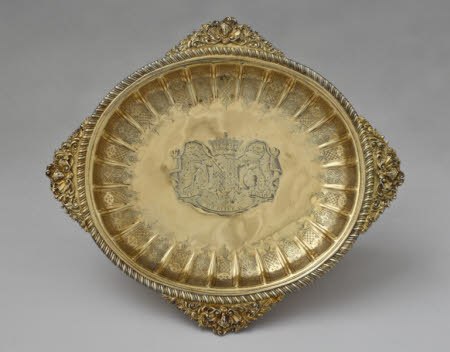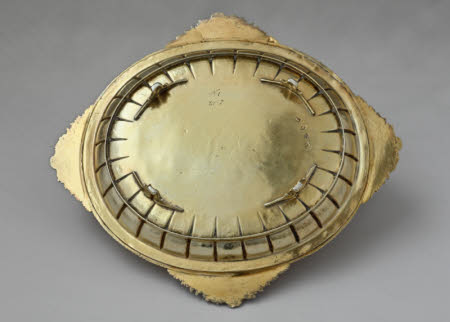Dish
Paul de Lamerie (1688 - London 1751)
Category
Silver
Date
1724 - 1725
Materials
Silver
Measurements
5 x 33.7 x 29.6 cm
Place of origin
London
Order this imageCollection
Ickworth, Suffolk
NT 852064.1
Summary
Silver-gilt dessert dish, formerly the dish from an epergne, by Paul de Lamerie, London, 1724/5. The oval dish is raised and has a series of narrow ribs around the perimeter, the compartments thereby created being flat-chased and engraved with foliate strapwork panels, alternately decorated with stylised leaves on matted grounds and trelliswork. There is a cast gadrooned rim and four cast triangular handles, each with a three-dimensional classical bust against an irregular shell and scrolling foliage, the backgrounds matted. The base of the dish is fitted with a seamed bezel and four scroll feet. Heraldry: The centre of the dish was re-engraved c.1751 with the quartered shield, supporters and motto of the 2nd Earl of Bristol in an ermine mantling and beneath an earl’s coronet.
Full description
This dish would have fitted into the top of the tureen of the Scarsdale epergne (see NT 852084) as an alternative to the cover, in the same way as does the dish of the intact Kirkleatham epergne at Temple Newsam.[1] Its fluted form suggests the circular salad dishes of the early eighteenth century which were also used for dessert and thus sometimes called strawberry dishes.[2] It would have been put in place once the initial courses of the meal had been completed, and been mounded with fruit or sweetmeats along with the vanished epergne saucers which would have projected on arms and been decorated to match. Glass liners were often provided for such dishes and saucers, protecting the silver and its intricate Régence decoration from the acidic fruit. These liners accompanied all of George Wickes’ epergnes of the 1730s and 40s, Viscount Duncannon being provided with ‘8 cutt saucers’ at 16s in 1740 whilst the ill-fated Admiral Byng received ‘2 ovell & 8 round Glass Saucers’ with his ‘Epargne with 4 branches’ in 1749.[3] It is to be hoped that at some point examples of these glass liners will be identified. An alternative dish shape was the extended octagon, as on the Williams epergne, but oval seems to have been more popular and to have persisted longer, outlasting even the inclusion of tureens in epergnes. A fine example with a frothily rococo cast border and wavy fluting is, for instance, found as late as 1753 on an epergne by Eliza Godfrey.[4] Paul de Lamerie seems only ever to have used the oval form and on at least one other epergne dish, that made for the 6th Earl of Mountrath in 1737, he combined it again with the prominent cast handles employed for Lord Scarsdale thirteen years earlier.[5] These handles, in quadruplicate, are also to be found on an inkstand of 1732 by de Lamerie [6] and it is possible that the same moulds were employed when the Scarsdale dish was duplicated for the 2nd Earl of Bristol by Frederick Kandler in 1751 (No. 2) and again in 1766 when another pair was added (Nos. 3 & 4). The whole set was then gilded to serve as dessert dishes and this use resulted in the miscomprehension in the twentieth century, starting with P. A. S. Phillips in his 1935 work on Paul de Lamerie, that the piece had been intended for that purpose from the beginning.[7] The same mistake has previously been made in relation to a number of other remnant dishes from epergnes, such as that of 1734 by de Lamerie in the Ashmolean Museum which still has its six accompanying saucers.[8] Some, like that at Ickworth, retain the bezel which allowed the dish to fit securely onto the tureen.[9] James Rothwell, Decorative Arts Curator January 2021 [Adapted from James Rothwell, Silver for Entertaining: The Ickworth Collection, London 2017, cat. 13, pp. 84-6]. Notes: [1] James Lomax, British Silver at Temple Newsam and Lotherton Hall, 1992, pp. 88-9, ill. [2] See Timothy Schroder, British and Continental Gold and Silver in the Ashmolean Museum, 2009, cat. 86, pp. 240-242 for a clear summary of the current understanding of fluted salad dishes. [3] National Art Library, Garrard Ledgers, VAM 1 1735–40, f. 193 and VAM 3 1747–50, f. 83. [4] Christie’s 15 June 1977, lot 116. [5] Christie’s 17 December 1986, lot 240 and Hare 1990, cat. 87, pp. 134-5, ill. [6] Sir Charles Jackson, Illustrated History of English Plate, 1911, p. 904, fig. 1181. [7] P. A. S. Phillips, Paul de Lamerie, 1935, p. 82. [8] Schroder 2009 (see note 2), cat. 103, pp. 279-81. Schroder has identified the set as being from an epergne but notes that they were previously described as dessert dishes. [9] See, for example, that of 1742 by John Hugh Le Sage supplied to the 4th Marquess of Tweeddale as Secretary of State for Scotland by the Jewel Office as part of a surtout, sold at Christie’s, 23 March 1966, lot 23.
Provenance
Nicholas Leke, 4th Earl of Scarsdale (d. 1736); 1st Earl of Bristol (bought, as part of an epergne, 1737, at the Scarsdale sale); by descent to the 4th Marquess of Bristol; accepted by the Treasury in lieu of death duties in 1956 and transferred to the National Trust.
Credit line
Ickworth, the Bristol Collection (National Trust)
Marks and inscriptions
Underside: Hallmarks: Lion’s head erased, Britannia, maker’s mark ‘LA’ star and closed crown above fleur-de-lis below (third mark, unregistered – see Susan Hare (ed.), Paul de Lamerie, At the Sign of the Golden Ball, London, 1990), date letter ‘I’ for 1724/5. Underside: Scratchweight: ‘N1 [/] 31=7’
Makers and roles
Paul de Lamerie (1688 - London 1751) , goldsmith

